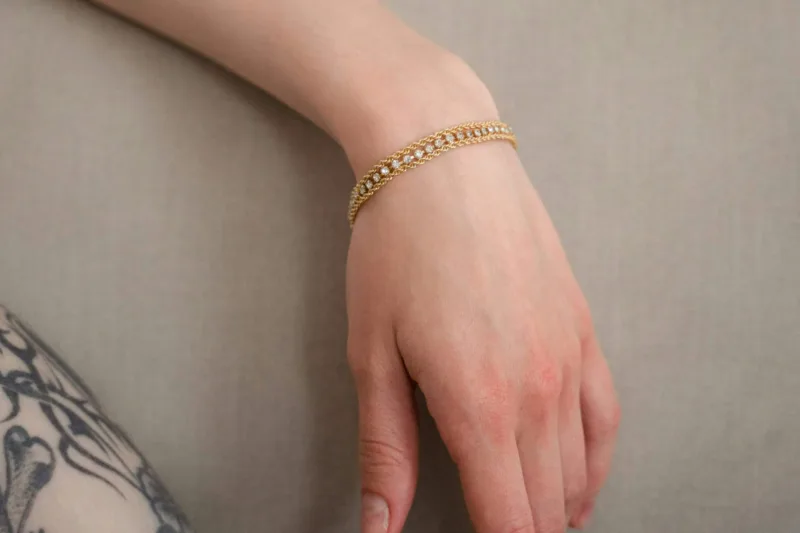In recent years, the global economy has witnessed fluctuations that have significantly impacted various sectors, including the jewellery market. In Singapore, rising gold prices have not only affected the purchasing power of consumers but also influenced their buying habits and preferences. As gold continues to be a symbol of wealth and status, understanding how these price changes shape jewellery buying trends is essential for both consumers and retailers alike.

The Current Landscape of Gold Prices
Gold prices have been on an upward trajectory, driven by various factors such as geopolitical tensions, inflation concerns, and changes in monetary policy. As investors flock to gold as a safe-haven asset, the price per ounce has seen substantial increases. This rise has created a ripple effect in the jewellery market, particularly in regions like Singapore, where gold holds cultural significance. The allure of gold is not just in its physical beauty but also in its historical role as a symbol of wealth and prosperity, making it a coveted item for both investment and adornment.
The current price of 22-carat gold in Singapore is approximately SGD 133.20 per gram. This is equivalent to SGD 1,065.60 for 8 grams, SGD 1,332 for 10 grams, and SGD 13,320 for 100 grams. According to Goodreturns, a financial website, 22-carat gold is also known as 916 gold, due to the 91.6% gold content.
Here’s a breakdown:
1 gram: SGD 133.20
8 grams: SGD 1,065.60
10 grams: SGD 1,332
100 grams: SGD 13,320
These prices are based on current market rates and are subject to fluctuation.
Factors Influencing Gold Prices
Gold prices and buying trends in Singapore are often influenced by the broader regional dynamics, including those in neighbouring Malaysia. Economic factors like instability, currency fluctuations, and international trade agreements contribute to gold price fluctuations in both countries. As a common trend, economic instability drives investors towards gold as a safe haven, increasing demand and pushing prices higher. This demand is further exacerbated in Singapore by local preferences for gold jewellery, which are also influenced by the trends seen in Malaysia.
In addition, the rise in gold prices in Malaysia has a ripple effect on the Singapore market. Some Malaysian gold jewellery brands are present in Singapore, catering to local consumers who are drawn to the unique craftsmanship and designs. However, the demand for Malaysian gold jewellery also means that Singaporeans must consider the increased prices resulting from regional trends and supply chain disruptions, particularly in the wake of the global pandemic, which has impacted gold availability.
Gold prices in Singapore are also shaped by the country’s reputation as a gold hub, offering competitive pricing and a favourable tax environment, including no Goods and Services Tax (GST) on investment-grade gold. This pricing advantage has led many to purchase gold in Singapore, as it remains an attractive option despite the fluctuations in the global market. Meanwhile, Malaysia’s own gold market, with its distinct price dynamics and preferences, often serves as a benchmark for consumers in Singapore when making purchasing decisions.
Consumers in both countries are becoming increasingly conscious of the origins of their gold, as ethical sourcing and sustainability continue to play a significant role in buying patterns. As such, the growing interest in responsibly sourced gold is a trend that transcends borders, affecting both Malaysian and Singaporean markets alike.
In conclusion, while there isn’t a direct link between physical gold shops in Singapore exclusively selling Malaysian gold, the interwoven nature of these markets means that trends, pricing, and consumer behaviours in one country often reverberate in the other, contributing to the dynamic gold buying environment in both nations.
Impact on Consumer Behavior
As gold prices rise, consumers in Singapore are adapting their buying behavior. Many are opting for smaller, more affordable pieces rather than larger, more extravagant items. This shift reflects a broader trend of value-seeking among consumers who still wish to invest in gold but are mindful of their budgets. The rising prices have also sparked a renewed interest in gold savings schemes, where consumers can invest in gold over time, allowing them to accumulate pieces without the burden of a single large purchase.
Furthermore, the increased cost of gold has prompted consumers to prioritise quality over quantity. Shoppers are more inclined to purchase unique, handcrafted pieces that offer a distinct aesthetic rather than mass-produced items. This trend not only supports local artisans but also fosters a deeper appreciation for craftsmanship. In addition, the rise of online marketplaces has made it easier for consumers to discover and purchase bespoke jewellery, allowing for a more personalised shopping experience. As a result, the jewellery market is witnessing a renaissance, where the stories behind each piece become just as valuable as the gold itself, enriching the consumer’s connection to their purchases.

Jewellery Buying Trends in Singapore
The jewellery market in Singapore is evolving in response to rising gold prices. Consumers are increasingly discerning, leading to notable trends that reflect their changing preferences and values. Retailers must adapt to these trends to remain competitive in the market.
Shift Towards Sustainable and Ethical Jewellery
One significant trend is the growing interest in sustainable and ethically sourced jewellery. As consumers become more aware of the environmental and social implications of their purchases, there is a heightened demand for jewellery that aligns with their values. Many are seeking pieces made from recycled materials or gold sourced from responsible mines.
This shift is particularly relevant in Singapore, where consumers are increasingly prioritising sustainability. Retailers who can offer transparency in their sourcing and production processes are likely to attract a loyal customer base that values ethical considerations alongside aesthetics.
The Rise of Customisation
Another trend gaining traction is the desire for customised jewellery. As gold prices rise, consumers are looking for ways to make their purchases more personal and meaningful. Customisation allows individuals to create unique pieces that reflect their personal style and story.
Jewellery retailers in Singapore are responding to this trend by offering bespoke services, enabling customers to design their own pieces or modify existing ones. This approach not only enhances customer satisfaction but also drives higher sales, as personalised items often carry a premium price tag.
Online Shopping and Digital Engagement
The digital landscape has transformed the way consumers shop for jewellery. With rising gold prices, many are turning to online platforms to compare prices, explore options, and make informed decisions. E-commerce has become a vital channel for retailers, allowing them to reach a broader audience while providing convenience to consumers.
Social media also plays a crucial role in shaping jewellery buying trends. Platforms like Instagram and Pinterest serve as sources of inspiration, showcasing the latest designs and styles. Retailers who leverage these platforms effectively can engage with potential customers and drive traffic to their online stores.

The Role of Cultural Significance
In Singapore, gold jewellery carries significant cultural importance, particularly within the Chinese community. Traditionally, gold has been associated with wealth, prosperity, and good fortune. As gold prices rise, this cultural significance continues to influence buying trends, albeit in new ways.
Gold as an Investment
Many consumers view gold not just as a decorative item but as a form of investment. With rising prices, there is a growing awareness of the potential for gold to appreciate over time. This perspective encourages consumers to purchase gold jewellery as a means of securing their financial future.
In this context, retailers are increasingly marketing their products as investment pieces, highlighting the intrinsic value of gold alongside its aesthetic appeal. This dual messaging resonates with consumers who are looking for both beauty and financial security in their purchases.
Celebratory Purchases
Gold jewellery is often associated with significant life events, such as weddings, anniversaries, and festivals. As prices rise, consumers may be more selective about their purchases for these occasions, opting for pieces that offer lasting value and meaning.
Retailers can capitalise on this trend by creating collections specifically designed for celebrations, emphasising the emotional and cultural significance of their jewellery. By aligning their offerings with consumer values, they can foster deeper connections with their customers.

Challenges for Retailers
While rising gold prices present opportunities for innovation and growth, they also pose challenges for jewellery retailers in Singapore. Adapting to changing consumer preferences requires agility and strategic planning.
Managing Inventory and Pricing Strategies
One of the primary challenges retailers face is managing inventory in a volatile market. With fluctuating gold prices, determining pricing strategies becomes increasingly complex. Retailers must strike a balance between offering competitive prices and maintaining profitability.
Additionally, retailers need to be proactive in adjusting their inventory to reflect current trends. As consumers gravitate towards smaller, more affordable pieces, retailers may need to diversify their offerings to cater to this demand while ensuring they have enough stock to meet customer needs.
Building Customer Loyalty
In a competitive market, building customer loyalty is crucial for long-term success. Retailers must focus on creating exceptional shopping experiences that foster trust and satisfaction. This involves not only providing high-quality products but also offering personalised services and engaging with customers through various channels.
Implementing loyalty programs and incentives can also encourage repeat purchases, particularly as consumers become more selective with their spending. By cultivating a loyal customer base, retailers can navigate the challenges posed by rising gold prices more effectively.

The Future of Jewellery Buying in Singapore
As gold prices continue to rise, the jewellery market in Singapore is likely to evolve further. Understanding consumer behavior and adapting to trends will be essential for retailers seeking to thrive in this dynamic environment.
Embracing Technological Innovations
The integration of technology into the jewellery shopping experience is expected to grow. Virtual try-ons, augmented reality, and artificial intelligence are becoming more prevalent, allowing consumers to visualise how pieces will look before making a purchase.
Retailers who embrace these technological innovations can enhance the customer experience, making it easier for consumers to find the perfect piece of jewellery. This not only drives sales but also positions retailers as forward-thinking and customer-centric.
Continued Focus on Sustainability
As sustainability becomes a central theme in consumer decision-making, jewellery retailers will need to prioritise eco-friendly practices. This includes sourcing materials responsibly, reducing waste, and promoting transparency in their supply chains.
By aligning their business practices with consumer values, retailers can build trust and loyalty among environmentally conscious shoppers. This focus on sustainability will likely shape the future of jewellery buying in Singapore, creating a market that values both beauty and responsibility.
The rising gold prices in Singapore are reshaping the jewellery buying landscape, prompting consumers to rethink their purchasing decisions. As trends shift towards sustainability, customisation, and online engagement, retailers must adapt to meet the evolving needs of their customers.
While challenges exist, the opportunities for innovation and growth are significant. By understanding the cultural significance of gold and embracing new technologies, retailers can thrive in a market that values both aesthetic appeal and ethical considerations. The future of jewellery buying in Singapore is bright, driven by a blend of tradition, modernity, and a commitment to sustainability.








Article
How Rising Gold Prices Are Shaping Jewellery Buying Trends in Singapore
Rising gold prices are significantly influencing jewellery buying trends in Singapore. With gold prices surging by over 50% in recent years, consumers are becoming more selective, often opting for lighter, more affordable pieces or investing in gold jewellery as a long-term asset.